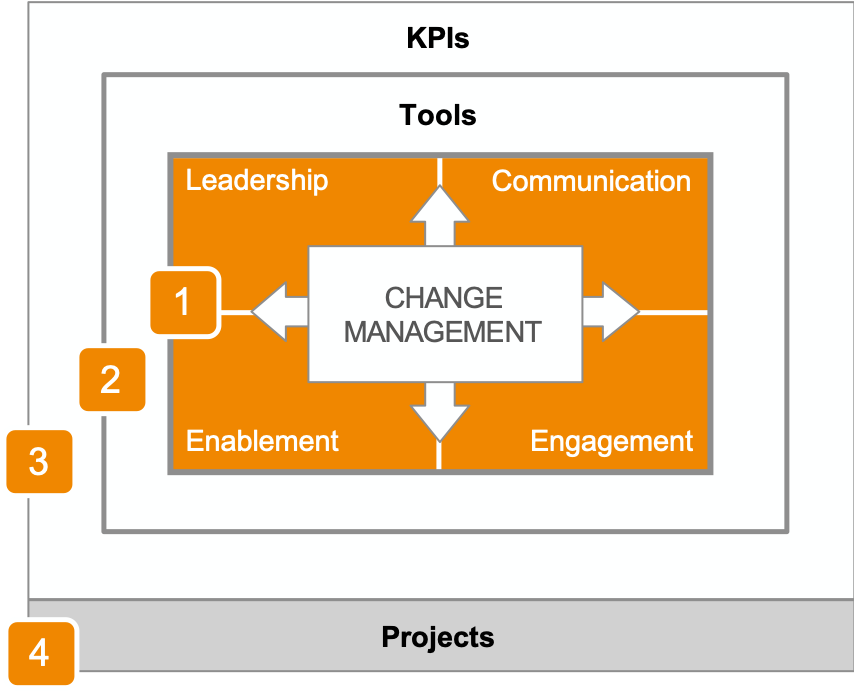
change before you need to: why change management should be a part of every project
by melanie wimmer and alexandra zöller
Constant change is a characteristic feature of today’s society, fueled by an ever-present digitalization, which is now affecting practically every area of our lives. This change is particularly noticeable in retail. Many traditional and long-established stores are closing. Even big chains and brands are struggling with declining customer frequency at bricks-and-mortar stores. Changes are inevitable in order to respond to this and reverse the negative trend.
To react to these challenges, rpc is focusing on the following questions: How can we enable companies and their processes, structures, people and corporate culture to adapt to a changing environment in the long run? What areas do companies need to tackle? What should they focus on?
It is important to not merely react, but to proactively drive change and shape the future with change management.
Change Management in the VUCA world
What is “change management”?
The meaning of change management has changed over time. Today, “change management” no longer means simply accompanying a change project and guiding the company from the initial situation “A” to the target state “B,” taking employees with you and finally establishing a new routine. Constant change is the new target state, if not even the “normal state.” Change management should therefore always be part of projects or transformations in order to ensure their success.
Change management: merely a soft factor?
But if you are facing the current truth within organizations, one has to admit that change management does not have a high standing. Often referred to as a “soft factor” or reduced to the aspect of communication, change management is rarely prioritized. The scope and the capacity required for successful transformation are also generally underestimated. In the event of cost reductions or budget cuts, this project component is often the first to be cut – based on the common opinion that change management has no direct business impact. Since there are hardly any structured approaches for measuring the influence of change management on a project’s success, this opinion is understandable. It is therefore understandable that the effect of change management on the success or failure of a project is underestimated or not recognized at all.
It is not the strongest of the species that survives, nor the most intelligent. It is the one that is most adaptable to change.
Our approach: rpc’s “Business Model Change”
At the same time, it is entirely possible to take a structured approach and implement targeted measures that influence a company’s success – which can be monitored and tracked with various KPIs. In the model “Business Model Change”, rpc has defined four fields of action for which specific tools can be applied in order to improve relevant KPIs. Change management not only entails communication – as is frequently supposed – but also leadership, motivation and enablement of employees. In turn, each of these areas can be used to set a wide range of priorities in order to lead change processes successfully. The objectives of a company may vary – from increasing customer satisfaction or improving brand value to cost and time reductions, so actions can be chosen based on those.
Within rpc’s “Business Model Change”, relevant levers, tools and KPIs are defined in order to highlight the impact of change management on the success of a transformation.
Master your transformation with rpc’s Business Model Change
Our Business Model Change focusses on the people dimension and contains different layers that provide orientation and direction on how to steer and manage a transformation effectively.
1) First layer: Four Levers
The first layer contains four levers, which are based on success factors of retail transformations, and focuses on the human factor within the transformation.
2) Second layer: Tools
The second layer consists of change management tools that help to master one or more of the four levers.
3) Third layer: KPIs
The third layer includes KPIs to measure the impact on one or more of the defined levers, in each case both qualitative and quantitative, on an individual and organizational level and from an internal and external view.
4) Foundation: Projects
The foundation of the model is made up of rpc projects that are underpinning the layers as references and provide practical experience and learnings.
Through a comprehensive end-to-end approach rpc supports its customers in identifying fields of action and setting up tailored programmes to achieve the defined goals. With this strategy, rpc provides its customers guidance for a successful transformation and thus offers genuine added value.
This article is also published on LinkedIn.






